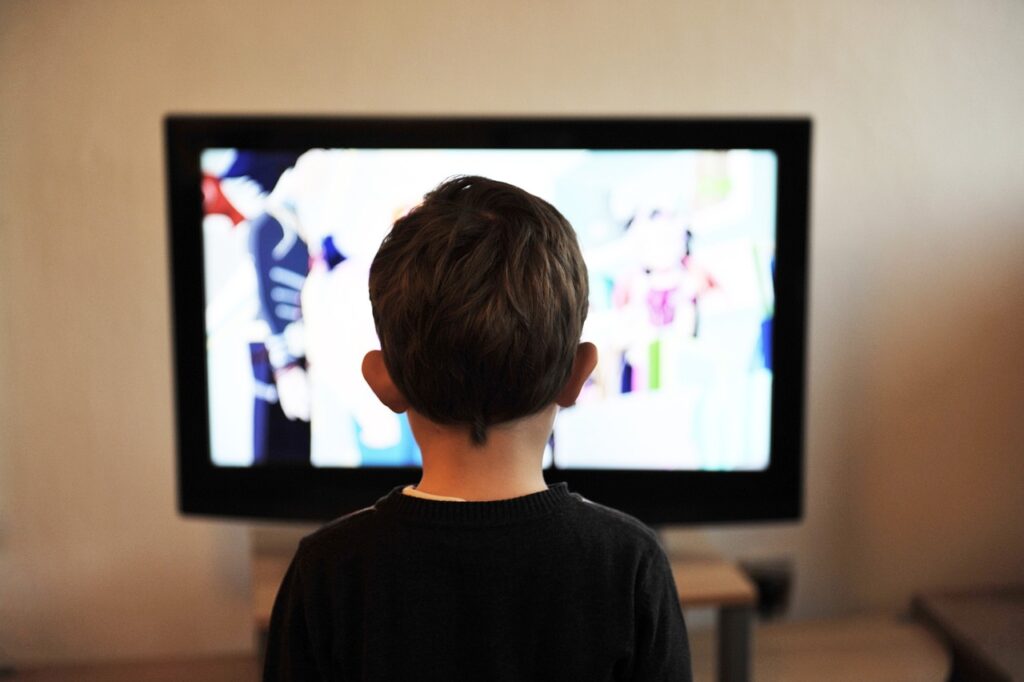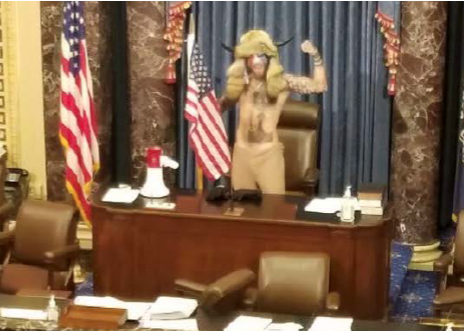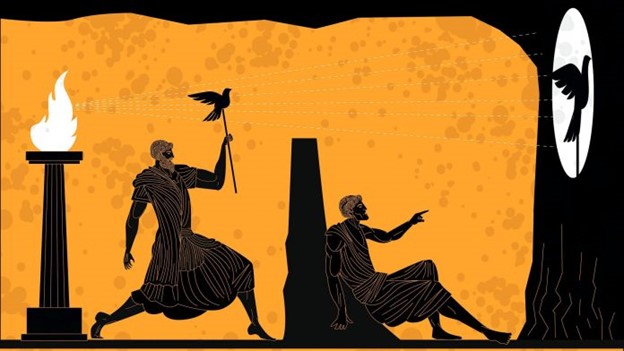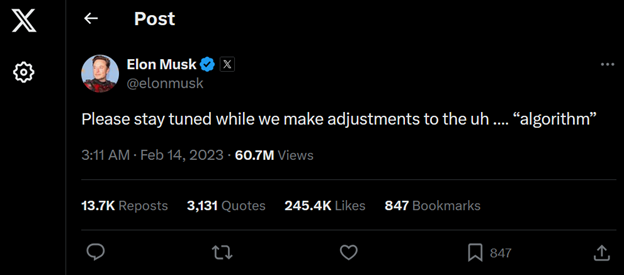
We guard the future for them, so that they can make the future as good as we dreamed it could be, when we were like them.
Image: Vidmir Raic on Pixabay.
By James Myers
Real life exists in three dimensions of space and one dimension of time that we all share.
Projected life on the screens of our “smart”phones and computers, however, exists in exactly half of the real dimensions: a screen has two dimensions of length and width, but lacks depth and it doesn’t share a common dimension of time with the viewer.
Screens squeeze four dimensions of living into two, and much confusion and discord can result when people believe the stereotypes of real life that they see playing out on their screens. This confusion and discord has become evident in the political polarization and tribalism that is sweeping the planet, a trend sparked and fuelled by the rise of social media primarily over the last decade.

The two dimensions of the static square, on the left, are much easier to copy than the four-dimensional complexity of the hypercube, on the right, which consists of many more squares in motion, together in time.
There are many dangers inherent when two-dimensional projections are mistaken for four-dimensional reality.
Social media gives anyone a platform to project their influence on others, but the problem is that the platforms are not only used by well-intentioned humans but also by bots, spammers, liars, and criminals too. Since projections can be made anonymously, using pseudonyms, it’s easy and free on these platforms for users – including foreign governments – to project divisiveness and stir rage driven by hidden agendas to manipulate elections and other human actions. Many people will and do fall victim to the provocations, and join causes they might have otherwise avoided if they had taken the time to reflect on the future consequences.
We know of no serious argument that social media has not been used, in a significant measure, to spread social discord. If any reader knows of such an argument, please forward it to us.
The dangers of stereotyping are so great that governments of the people, by the people, and for the people absolutely and urgently must do more to safeguard four-dimensional life as we live it, not as it is reduced on our screens.

Photograph of rioters storming the U.S. Capitol on January 6, 2021. Is this the way of government of the future? Image shared by Reuters.

A shirtless rioter wearing a horned hat took over the Speaker’s chair at the January 6, 2021 riot at the United States Capitol. Is this the way of government of the future? Image: Wikipedia

Polarized opinions projected through social media helped to fuel the rage of the rioters who overtook the U.S. Congress on January 6, 2021. Is this the way of government of the future? Image shared by Reuters.
Regulatory measures will be strongly opposed, principally by the companies subjected to regulation.
However, in the long run the companies might realize that working cooperatively with regulators to maintain a vibrant four dimensions of reality will be as good for business as it’s good for the rest of us, the customers. That’s because there’s exponentially greater potential to generate future data – and therefore future profit – in four dimensions than in two. Preserving future potential is good for the corporate bottom line in the long run, because the long run is what truly matters.
A world on fire is worth much less than a world at its creative best.
It’s fundamentally a question of increasing present value, which is what investors naturally want to do. The value decrease would be especially acute if the customers fall into a two-dimensional feedback loop. That’s when they begin copying the most influential projections they see or hear, because it will earn them the most “Likes,” and in turn they will project copies of what they have copied onward for others to copy. There are endless copies in a feedback loop.
It’s much easier to copy in two dimensions than it is in four; it’s exponentially easier, in fact, and some mathematicians might say that four dimensions are infinitely more difficult to copy than two. It’s certainly a fact of geometry that four dimensions are far more complex than two, and we are people of a geometric universe. Of that we can have no doubt, because the universe spells itself out clearly in Einstein’s field equations.
Prisoners in the Cave
Over time with our screens, we risk becoming like the famous prisoner in Plato’s allegory of the cave written 2,400 years ago. You may have heard of that prisoner. He’s the poor fellow who was chained hand and foot and couldn’t turn his head to know that there are men behind him projecting moving shadows onto the two-dimensional cave wall. The wall is the only thing the prisoner can see, and the unseen men create the two-dimensional illusion for him by moving their hands in front of the light of their torches. The men know what they are doing, but the prisoner does not. To the prisoner, who knows no other reality, the two-dimensional wall is “real” just the same as we say that what our eyes see is “real.”

Image adapted from Plato’s allegory of the cave. In this modified version, the prisoner isn’t shackled but seems to be interacting willingly with the two-dimensional projection, and the projection is not from a human hand but from a manufactured object. Image: Ourpolitics.net.
The social media antics projected by some people can be at times entertaining, dramatic, or inflammatory (or all three).
But the more they are repeated, the more the antics over time become at first normal and then eventually stale. There’s little value in something that’s so predictable, and therefore stale data has far less monetary value than fresh data.
A decrease in value doesn’t look good on a company’s financial statements, or in the eyes of its investors. That’s why maintaining four-dimensional variability will be far more profitable in the long run for the companies as well as their customers. Unfortunately, there are few economic mechanisms that reward management and investors for short-term “pain” undertaken to achieve long-term “gain.” Instead of rewarding foresight, sometimes punishment is given for thinking ahead.
The Cave Can Be Profitable
 The dimensional reduction of life promoted on social media has been part of its incredibly profitable appeal. Meta, the public company that owns Facebook and Instagram, made a profit of $39 billion in its last fiscal year. Twenty years after its 2004 launch from Mark Zuckerberg’s Harvard University dorm room, Facebook now serves up two-dimensional representations of life to a staggering 2.11 billion active daily users (as reported in its 2023 financial disclosures). That’s roughly one-quarter of the world’s population, each of whom can influence or be influenced on the platform. The science of influence is rapidly evolving, with individuals now earning large amounts by acting as online “influencers.”
The dimensional reduction of life promoted on social media has been part of its incredibly profitable appeal. Meta, the public company that owns Facebook and Instagram, made a profit of $39 billion in its last fiscal year. Twenty years after its 2004 launch from Mark Zuckerberg’s Harvard University dorm room, Facebook now serves up two-dimensional representations of life to a staggering 2.11 billion active daily users (as reported in its 2023 financial disclosures). That’s roughly one-quarter of the world’s population, each of whom can influence or be influenced on the platform. The science of influence is rapidly evolving, with individuals now earning large amounts by acting as online “influencers.”
 Platforms like Facebook and X, the latter now owned by Elon Musk, offer great power to anyone to say or do practically anything within legal bounds – and sometimes to find their way around legal limits and any boundary of respectability. By virtue of its enormous global reach, which is many multiples of the number of X’s users, Facebook is especially powerful because it costs the influencers nothing to project images to a quarter of the planet’s population. The cost of the technology and the profit it drives for Meta’s shareholders are funded almost entirely from advertising targeted with the data that the company freely gathers by tracking us.
Platforms like Facebook and X, the latter now owned by Elon Musk, offer great power to anyone to say or do practically anything within legal bounds – and sometimes to find their way around legal limits and any boundary of respectability. By virtue of its enormous global reach, which is many multiples of the number of X’s users, Facebook is especially powerful because it costs the influencers nothing to project images to a quarter of the planet’s population. The cost of the technology and the profit it drives for Meta’s shareholders are funded almost entirely from advertising targeted with the data that the company freely gathers by tracking us.
Better yet for some influencers is that their influencing can be done anonymously. It can even be automated.
The Projective Power of the World’s Richest Human
I’m not a user of the social media platform X, but a friend who is told me how postings by company owner Elon Musk now regularly and inexplicably appear at the top of my friend’s feeds. Musk’s algorithmic ranking is in spite of the fact that my friend does not follow Musk, nor does he share interest and perspective in the things that Musk does, and, frankly, nor does he even respect Musk. I am not stating my opinion in this; these are not my words, they are those of my friend.
It turns out that Musk’s prime positioning on my friend’s two-dimensional screen is not coincidental, a conclusion that has been widely reported with information gathered from X company insiders and the many former Twitter employees who were terminated soon after Musk took over the company and renamed it X.
As company insiders are reported to have stated, Musk was obsessed with his impression count (which is the number of users who see his postings) and wanted to do everything within his power to increase the number.
Multiple sources report that it was because President Biden’s posting on X, made during the 2023 Superbowl game, attracted 29 million impressions while Musk’s only received 9 million that the company’s owner very forcefully and urgently refocussed the efforts of staff. Reportedly as a result of the impression-snubbing, eighty staff members, a significant proportion of X’s employees, were set to work developing a means to promote Musk’s posts in ways that no other X user’s posts could possibly achieve.
Under pressure from their boss, employees reportedly developed a code to “greenlight” Musk’s postings automatically, allowing them to bypass filters designed to present users like my friend with individually relevant content. No other X user enjoys such greenlighting, nor is it disclosed to users that the owner’s posts have been greenlit, nor do users have a choice to opt out of being the targets of greenlighting.

Called to account for changing X’s algorithms boosting his own postings (“tweets”), Musk promised to adjust the “uh … ‘algorithm’ ” to reduce his prominence – which persists.
While Musk owns the company and there doesn’t seem to be a law against greenlighting, the point is that his views would not have been thrust on my friend if four-dimensional reality had been allowed to run its natural course. But sometimes four-dimensional reality can deliver distressingly low impression counts on social media, even for the world’s richest human.
At much cost to the company, and reportedly at the cost of several employees’ jobs when they hindered the quest, Musk’s posts now have pride of position on the screens of X users.

Article in the Monday, August 5, 2024 edition of The Guardian following widespread rioting in the U.K. Some viewed Musk’s posting as incitement of an already volatile situation.
The Projective Power of Meta’s Personas
A persona is a person’s image, and it’s supposed to be the image the way others see it. In four dimensions, each of us projects a unique persona that others like, dislike, or are indifferent to in varying degrees.
Personas are prone to stereotyping when they’re reduced to two dimensions on a screen. The viewer is left to guess what lies behind the image, in the carefully selected depth of the camera angle, in the lighting, and in the time before and after the image was taken. This was a central point of Marshall McLuhan in his brilliant 1962 Gutenberg Galaxy, which he wrote when television had just become widespread, and his words apply no less today because screens then and now are still two dimensional.

Meta announced in 2023 the creation of “AI personas.” Image: The Verge
Not long after Facebook’s creation in 2004, the platform was promoted for users to project a consistent persona to family, friends, and co-workers.
Users can live with “dual identities – online and in real life.” As Zuckerberg explained ten years ago to BusinessWeek, “If you’re always under the pressure of real identity, I think that is somewhat of a burden.” His selling point was an implicit acknowledgement that a consistent persona is impossible to maintain in four dimensions (and history has never demonstrated such a feat), but it’s much easier to do with a two-dimensional stereotype.
In the 2023 introduction of its Personas product, Facebook paid actors to be the basis for AI-generated personas which users could interact with. Want to be an adventurous storyteller? Then you could interact with a Snoop Dogg-driven “Dungeon Master” persona, but if that’s not your thing and you were feeling more like a detective, you could interact with a Paris Hilton “Amber” persona. The company’s experiment didn’t last too long, and now Facebook is replacing the curated celebrity personas with a product it calls “AI Studio” that allows users in the US to make chatbots of themselves.
If I were to do this, would it decrease my ability to invent a future persona when I continually interact with a copy of my persona as it is today? I don’t know whether my future self would like my present self as much as my present self likes itself, so I don’t think it’s something I would want to do. To be human is to be flexible with one’s persona. I would prefer to expand my persona, by interacting with other real people.

Facebook founder Mark Zuckerberg launched the company in 2004 from his Harvard University dorm room, when this photo was taken. Is he the same persona now? Image: Harvard Crimson, by Lowell K. Chow
Government of the People, by the People, for the People
Abraham Lincoln famously stated that a bloody civil war was being fought so that government of the people, by the people, for the people would not perish from this Earth.
Such governments can do a lot of bad things, and we get mad at them, because they’re made up of people and there is not a single person among us who hasn’t done bad or silly things. But being good people ourselves, we should have faith in our ability to promote and support good people in government to safeguard the future for the next generation. That’s ultimately what governments do, or should do, because the policies they enact today have very far-reaching consequences for the children of today and their children.
The children of today’s world, and their children, deserve the best governments that we can give them.
As frustrating as they can sometimes be, governments of the people, by the people, for the people are necessary for two reasons.
One reason is that government by tyrant never, ever, turns out to be good for the vast majority of the people. The tyrant is only ever good for a tiny number of people, for only a handful of years, and then the tyrant dies of natural causes (or otherwise) and his name becomes reviled in history. That’s the reason why people have never and will never spontaneously gather to celebrate a tyrant, because the tyrant celebrates the fear he sees in the eyes of the people he commands and the souls that he crushes.
No, people don’t spontaneously celebrate soul-crushers.
The other reason is that there’s no conceivable way that a planet of 7.8 billion ungoverned individuals could ever survive. Imagine the chaos! And so it’s incumbent on those who think governments are bad things to work to make them good things, because when there’s no government of the people, by the people, for the people there’s almost always tyranny, or chaos, or both.

Statue of Abraham Lincoln at the Lincoln Memorial, in Washington, DC. Photo by Carol Highsmith, from US National Parks Service.
The Gettysburg Address, 1863
“Four score and seven years ago our fathers brought forth on this continent, a new nation, conceived in Liberty, and dedicated to the proposition that all men are created equal.
“Now we are engaged in a great civil war, testing whether that nation, or any nation so conceived and so dedicated, can long endure. We are met on a great battle-field of that war. We have come to dedicate a portion of that field, as a final resting place for those who here gave their lives that that nation might live. It is altogether fitting and proper that we should do this.
“But, in a larger sense, we can not dedicate—we can not consecrate—we can not hallow—this ground. The brave men, living and dead, who struggled here, have consecrated it, far above our poor power to add or detract. The world will little note, nor long remember what we say here, but it can never forget what they did here. It is for us the living, rather, to be dedicated here to the unfinished work which they who fought here have thus far so nobly advanced. It is rather for us to be here dedicated to the great task remaining before us—that from these honored dead we take increased devotion to that cause for which they gave the last full measure of devotion—that we here highly resolve that these dead shall not have died in vain—that this nation, under God, shall have a new birth of freedom—and that government of the people, by the people, for the people, shall not perish from the earth.”
— Abraham Lincoln
It’s Not Us Against Them, or Them Against Us. People Are Governments Are People.
People and their governments of people are in a symbiotic relationship. It seems natural that a government of the people, by the people, for the people would want to preserve the people who are the government’s foundation. And it seems fitting that such governments should preserve the people of the future because, without the people, future governments would be of, by, and for nothing.
Preserving the people doesn’t end in two dimensions. It’s a complex job for four dimensions, one of which is the precious and relatively short (in a cosmic sense) dimension of time that we share and in which each one of us plays our part in life. All the world’s the stage, as Shakespeare wrote, and we are as actors playing our parts, making our entrances and exits.
Let’s play the best parts we can imagine, and set the best stage we possibly can, so today’s children and their children can play their roles in life too.
The four dimensions of space and time are human dimensions. They belong to all people who were, are, and will be, and the four dimensions are where all the beauty and the badness of living occur. Life in four dimensions seems far more preferable than living like the two-dimensional Flatlanders of Carl Sagan’s legendary depiction.
Would any human willingly trade potential in four dimensions, for the limits of two? Granted, it’s true that death wouldn’t be necessary in two dimensions, where the images can go on forever, but the images would become stale after so many repetitions.
Just imagine infinite stale imaging – or is it oxymoronic to think that such a thing could be imagined? When the images play over and over and over and over again on the length and width of the screen, there’s not much room left for imagination. Where would the depth be, and what would be the point of time?
So, would some regulations to guard against algorithmic stereotyping be a bad thing – for social media consumers as well as social media companies? It seems like a win-win proposition, and a sure bet on the future that both the influencers and the influenced can’t afford not to make.
Living in Two Dimensions: Carl Sagan’s Flatlanders



